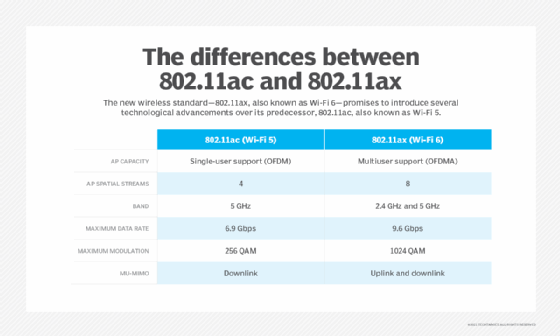802.11ac (Wi-Fi 5)
What is 802.11ac?
802.11ac, also known as Gigabit Wi-Fi, is a specification in the IEEE 802.11 family applicable to WLANs (wireless local area networks). 802.11ac represents an extension or update of the legacy 802.11a standard. 802.11ac sits between 802.11n and 802.11ax on the standards timeline and operates strictly in the 5 GHz spectrum.
802.11ac is also referred to as Wi-Fi 5, using the nomenclature derived by the Wi-Fi Alliance. Although still considered current to a certain degree, 802.11ac is being displaced by the latest standard, 802.11ax, also known as Wi-Fi 6.
When Wi-Fi access points (APs), wireless routers or client devices are described as 802.11ac-compatible, that means .11ac is supported in the 5 GHz spectrum. These devices are generally dual band, but the 2.4 GHz frequency side is still 802.11n, because .11ac is 5 GHz-specific.
How does 802.11ac work?
As with all 802.11 standards, 802.11ac is half-duplex, shared medium radio technology that works best when employed in wireless networking environments designed by qualified professionals.
Compared with previous wireless standards, 802.11ac has specific enhancements that mark its operational value and contribute to its overall top-end capabilities. These enhancements include channels up to 80 MHz wide, 256 quadrature amplitude modulation (QAM), multi-user multiple-input and multiple-output (MU-MIMO) and the potential for eight spatial streams.

What is the speed of 802.11ac?
As with all 802.11 standards, 802.11ac does not have a single speed that will be achieved every time it's used. In the real world, conditions and device characteristics vary widely, and so the maximum theoretical rates are rarely achieved outside of controlled environments. The theoretical maximum speed of 802.11ac is 1300 Mbps, which is impressive compared with the 450 Mbps theoretical maximum speed of 802.11n.
Benefits of 802.11ac
Every new 802.11 standard is generally better than the last. With 802.11ac versus 802.11n and earlier standards, wireless network engineers should expect the following benefits:
- faster data rates at a given range;
- higher per-cell overall capacity;
- increased bandwidth for more simultaneous devices; and
- more resiliency against interference when beamforming is used.
Limitations of 802.11ac
No current wireless local area network (WLAN) technology is immune to strong interference, and the power of all 802.11 standards is limited by regulations set forth by the Federal Communications Commission. Other limitations of 802.11ac include the following:
- A newer standard, 802.11ax, is available.
- 802.11ac hardware was produced in two waves -- Wave 1 and Wave 2 -- with performance differences that can be hard to keep straight where both device types are used.
- Although the standard enables up to eight spatial streams, most APs produced support just 2x2 or 4x4 spatial streams. At best, most client devices are 2x2.
802.11ac vs. 802.11ax (Wi-Fi 6)
While 802.11ac is a 5 GHz specification with theoretical data speeds that top 1 Gbps, 802.11ax is tri-band and covers 2.4 GHz, 5 GHz and 6 GHz Wi-Fi spectrum. 802.11ax is expected to deliver real-world Gbps+ speeds for clients that can support enough radios.
As 802.11ac was a huge leap forward from .11n, .11ax is likewise a significant step up from .11ac. From a modulation perspective, .11ax supports 1024 QAM compared with 256 QAM for .11ac.
The list of enhancements for 802.11ax is long and noteworthy. While 802.11ac is impressive, 802.11ax is more so by an order of magnitude.
How to upgrade from 802.11ac
If organizations are sticking with their incumbent WLAN vendor as they upgrade, the following steps are required:
- Verify the existing WLAN design is valid for client counts and for the coverage areas required.
- If additional APs are needed, run and certify the cable for them.
- Ensure Power over Ethernet switches can handle the power requirements of 802.11ax APs. If not, upgrade the switches.
- Secure any different or additional licenses that are required to accommodate new APs.
- Understand and configure any Wi-Fi Protected Access 3 security settings that may be required, especially if using 6 GHz on new APs.
- Using a change management process, schedule and conduct the upgrade.
- Finally, verify coverage and functionality.
The future of 802.11ac
As 802.11ax continues to grab market share, 802.11ac products become harder to buy in the enterprise WLAN space. At the same time, 802.11ac has proven to be a solid standard that delivers impressive Wi-Fi that many organizations are not in a hurry to leave behind.
Some customers are burned out on the rapid turnover of wireless standards and are sitting tight on their current investment. Others, however, are waiting for the next standard -- 802.11be, or Wi-Fi 7 -- which is expected to make its presence known in the 2023 to 2024 timeframe. 802.11ac is certainly on the decline, but it will age out far slower than past wireless standards.
